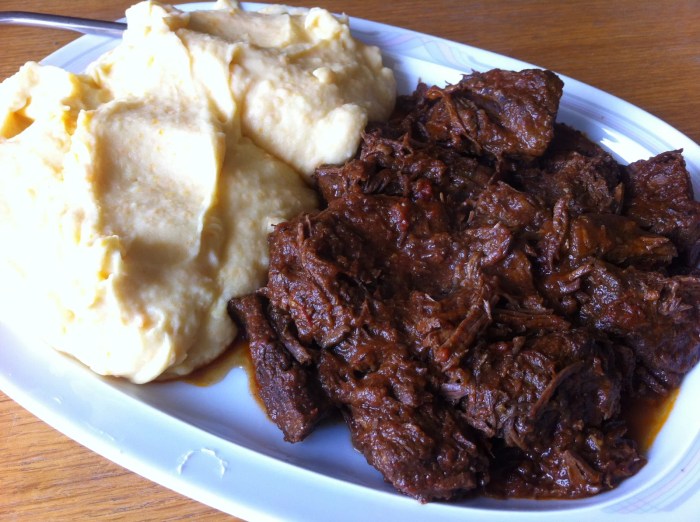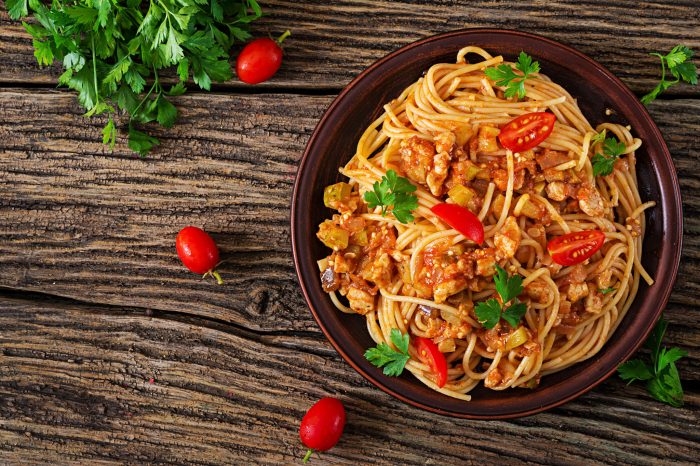Beef Recipes with Tomato Sauce A Culinary Exploration
Beef and Tomato Sauce: A Culinary Exploration: Beef Recipes With Tomato Sauce
Beef recipes with tomato sauce – The combination of beef and tomato sauce is a cornerstone of countless cuisines worldwide, a testament to its enduring appeal and versatility. From hearty stews to elegant ragùs, the rich, savory depth of beef perfectly complements the bright acidity and umami notes of tomato sauce. This exploration delves into the history, techniques, and diverse expressions of this classic pairing.
Introduction to Beef and Tomato Sauce Combinations

Source: greek-recipe.com
The history of beef and tomato sauce is intertwined with the global spread of tomatoes themselves. While tomatoes originated in the Americas, their culinary prominence exploded in Europe following the Columbian Exchange. Italian cuisine, in particular, embraced the tomato, leading to the development of iconic dishes like ragù alla Bolognese. The cultural significance lies in the ease of preparation and adaptability of the combination, making it a staple in many cultures, each adding its own unique twist.
A wide array of beef cuts lend themselves to tomato-based recipes. Leaner cuts like sirloin or flank steak work well in stir-fries or quick-cooking dishes, while tougher cuts like chuck roast or brisket benefit from long, slow cooking in tomato sauce, resulting in incredibly tender and flavorful results. Short ribs, with their rich marbling, are also a popular choice, adding a luxurious depth of flavor.
The flavor profile achieved by marrying beef with tomato sauce is remarkably multifaceted. The inherent savory nature of beef provides a robust base, while the tomato sauce contributes acidity, sweetness, and umami. The addition of herbs and spices further enhances the complexity. Classic pairings include oregano, basil, thyme, and bay leaf, but the possibilities are endless, with options ranging from fiery chili flakes to warming cinnamon and cloves, depending on the desired regional or cultural influence.
Classic Beef Recipes with Tomato Sauce

Source: minerva-foods.com
Several timeless recipes showcase the versatility of beef and tomato sauce. These recipes offer a foundation for culinary creativity, allowing for personalized adjustments and flavor explorations.
Traditional Beef Stew
This comforting classic is a testament to the power of slow cooking. The long simmering process allows the beef to become incredibly tender, while the flavors meld beautifully.
| Ingredient | Quantity (4 servings) | Ingredient | Quantity (4 servings) |
|---|---|---|---|
| Beef Stew Meat | 1.5 lbs | Flour | 2 tbsp |
| Onion, chopped | 1 large | Carrots, chopped | 2 cups |
| Potatoes, cubed | 2 cups | Canned Diced Tomatoes | 28 oz |
| Beef Broth | 4 cups | Bay Leaf | 1 |
| Salt & Pepper | To taste | Thyme | 1 tsp |
Beef Meatballs in Tomato Sauce
These savory meatballs are a crowd-pleaser, perfect for a family dinner or a casual gathering. The key to exceptional meatballs lies in the proper balance of ingredients and a gentle hand during preparation.
- Combine ground beef, breadcrumbs, egg, grated Parmesan cheese, minced garlic, onion, salt, and pepper in a bowl.
- Gently mix the ingredients until just combined; avoid overmixing.
- Roll the mixture into 1-inch meatballs.
- Brown the meatballs in olive oil over medium heat.
- Transfer the browned meatballs to a saucepan. Add your favorite tomato sauce and simmer until heated through.
Simple Beef and Tomato Pasta Sauce
This versatile sauce is perfect for a quick weeknight meal. The simplicity allows for easy customization with different pasta shapes and additions.
Sauté diced beef with garlic and onion. Add canned crushed tomatoes, herbs (basil, oregano), and simmer until the sauce has thickened slightly. Toss with your choice of pasta – penne, spaghetti, or even farfalle work well. Consider adding a splash of red wine for extra depth.
Exploring Variations: Regional and International Influences
Beef and tomato sauce recipes vary widely across cultures, showcasing diverse flavor profiles and culinary techniques. These variations reflect the unique ingredients and culinary traditions of different regions.
Italian Ragu vs. Mexican Beef in Tomato Sauce
Italian ragù, particularly Bolognese, is known for its slow-cooked, rich tomato sauce often incorporating pancetta, vegetables, and red wine. Mexican beef in tomato sauce, often found in dishes like carne guisada, tends to be spicier, featuring chiles, onions, and often cumin and oregano.
Key Ingredients and Techniques
Regional differences are often reflected in the choice of spices, herbs, and cooking techniques. For example, South American recipes might incorporate aji amarillo peppers for a distinct flavor, while Asian-inspired versions could incorporate soy sauce, ginger, and garlic.
Bulgogi-Inspired Beef and Tomato Stir-Fry
This recipe takes inspiration from Korean Bulgogi, combining marinated beef with a vibrant tomato-based stir-fry sauce. The sweet and savory marinade infuses the beef with rich flavor, while the addition of sesame oil and gochujang adds a unique twist to the classic tomato sauce. The final dish boasts a beautiful medley of colors and textures, with tender beef slices coated in a glossy, deeply flavorful sauce.
Garnishing with toasted sesame seeds and sliced green onions enhances both the visual appeal and the overall flavor experience.
Beef and Tomato Sauce: Techniques and Tips
Mastering a few key techniques can elevate your beef and tomato sauce dishes from good to exceptional.
Browning the Beef
Browning the beef before adding tomato sauce is crucial for developing deep, rich flavors. The Maillard reaction, which occurs during browning, creates complex compounds that enhance the overall taste.
Achieving a Rich and Flavorful Tomato Sauce
Start with high-quality canned tomatoes or fresh tomatoes roasted for maximum flavor. Simmering the sauce for an extended period allows the flavors to deepen and meld. Adding a touch of sugar can balance the acidity, while a splash of red wine adds complexity.
Simmering Techniques
Simmering beef in tomato sauce over low heat ensures tender results. Longer simmering times are ideal for tougher cuts, allowing the connective tissues to break down. Monitoring the liquid level and adding more broth or water as needed prevents the sauce from becoming too thick.
Serving Suggestions and Pairings
The versatility of beef and tomato sauce dishes allows for numerous pairing options to complement and enhance the overall dining experience.
Side Dish Suggestions
- Vegetables: Roasted vegetables (broccoli, carrots, potatoes), sautéed spinach, green beans.
- Starches: Mashed potatoes, polenta, pasta (various shapes), rice.
- Salads: Simple green salad with vinaigrette, Caprese salad.
Beverage Pairings
A full-bodied red wine, such as a Cabernet Sauvignon or Chianti, complements the richness of the beef and tomato sauce. Alternatively, a crisp Italian white wine or a light-bodied beer can also work well.
Presentation Techniques
Garnish the dish with fresh herbs (basil, parsley), a drizzle of olive oil, or a sprinkle of grated Parmesan cheese to enhance its visual appeal. Serving the dish in a rustic bowl or on a platter can further elevate the presentation.
Key Questions Answered
Can I use canned tomatoes instead of fresh?
Yes, canned tomatoes are a convenient substitute for fresh. Choose high-quality canned tomatoes, preferably San Marzano, for the best flavor.
How long should I simmer the beef for optimal tenderness?
Simmering time depends on the cut of beef. Tougher cuts require longer simmering times (up to 3 hours or more) to become tender. Check for tenderness with a fork.
What are some good ways to thicken the sauce?
You can thicken the sauce by reducing it on the stovetop, adding a cornstarch slurry, or using tomato paste.
What type of wine pairs well with beef and tomato sauce?
A full-bodied red wine like Cabernet Sauvignon or Chianti Classico complements the richness of beef and tomato sauce.





















